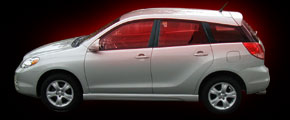Toyota Matrix (2003)
 |
||
 |
 |
 |
|
||||||
| Good: all-wheel drive, roomy, cool styling Bad: red instrument lights, ride, visiblity |
 |
 |
 |
 |
||
|
|
||||
|
The Toyota Matrix has a number of things going for it. It has a neat looking "tall SUV-ish wagon" exterior. It has good, versatile interior room. It has Toyota reliability. It has optional all-wheel drive. And it's cheap -- relatively cheap. The basic two-wheel-drive Matrix has a Cars.com target price of $14,430, while the fancier, all-wheel-drive version we drove has a target price of around $18,400. What it doesn't have is much in the way of sporty handling or excess power. But what do you want for 18 grand? Toyota used to make a Corolla wagon, which had many happy customers. Well, not that many, I guess, because Toyota dumped it. Now, the Matrix fills that slot in Toyota's lineup. It's based on the new Corolla platform. It's got wagon versatility and optional all-wheel drive. It's definitely more youthful looking, with a tall roofline and SUV inspired design details. But at heart it's an economy car. This is good...if you're looking for an economy car. But if you're looking for a sporty wagon, we'd have to send you elsewhere. |
||||
|
|
||||
 |
The engine in the Matrix is adequate. It's the same 1.8 liter, 130-horsepower four-cylinder that's used in the Corolla. It's incredibly smooth, and feels like it has plenty of pep for errands around town. But out on the highway, the engine feels a little under-prepared. The Matrix starts to run out of steam on uphill grades on the interstate, often forcing the transmission to shift down a gear just to maintain speed. Toyota does offer a souped-up version of the Matrix, the XRS, with a 180-horsepower, four-cylinder engine -- the same engine used in the Celica GTS. We're sure it's a lot faster and perhaps it handles better (we haven't driven one yet), but you can't get all-wheel drive on the XRS, which makes it a lot less appealing to us. Unlike most Toyotas, we found the Matrix's ride to be a bit harsh. We also found the body lean in corners to be irritating, and the lack of passing power unfortunate at times. It wasn't awful, but it was a reminder of the Matrix's economy car roots. |
|||
|
|
||||
 |
There's 22 cubic feet of cargo space behind the rear seat, which expands to a little more than 53 cubic feet with the rear seats folded. That's decent, but not huge; it's less than you'd get in a Toyota RAV4 or even a Subaru Impreza wagon. But it's sufficient for most Home Depot search-and-retrieve missions. Scattered through the interior are a plethora of cubbies large and small, from a reasonably sized glove compartment to hard bins under the seats to a chintzy storage console between the front seats.
The Matrix comes with anti-lock brakes, air conditioning, an air-filtration system, AM-FM-CD player and a tilt wheel. Power windows and locks are standard on the XR model and optional on the base model. Side air bags are available only on the XRS model. |
|||
|
|
||||
 |
{C}
In general, Toyota did a pretty good job in terms of ergonomics. The shifter juts out of a little pod on the dashboard, like it does in the Lexus RX300 and the Toyota Highlander. It's a pretty benign change, and one that we had no trouble getting used to. The ventilation controls are three easy-to-use dials, and the dash vents make satisfying clicks as you adjust them.
|
|||
|
|
||||
 |
{C}
|
|||
|
|
||||
 |
Like every other Toyota, the Matrix should prove to be exceptionally reliable. We'd expect it to be as reliable as every other Toyota -- which means that you'll be tired of it long before it throws in the towel. |
|||
|
|
||||
 |
And, like every other Toyota, it looks like the designers have given some thought to service and maintenance. Major components like the water pump, timing belt and alternator are easy to reach. And, there's plenty of room inside the engine compartment. Those factors should make service and maintenance costs quite manageable. |
|||
|
|
||||
 |
{C}
|
|||